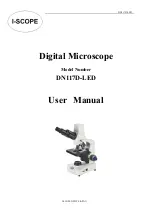
13
You will see small bits of dirt and vegetation. If you are lucky you may
see small creatures moving around. Some of these are tiny baby insect
larvae. Others are very tiny animals that live in the water and feed on the
vegetation and on the insect eggs and larvae.
Make careful notes and drawings of what you see.
Things I saw in pond water:
4
PROJECT #9: Friendly Bacteria
You will need: Your microscope
clean,
blank
slides
glass
slide
covers
a
pipette
yogurt (Must say “active cultures” on the label)
water
Petri dish
14
Bacteria are very small life forms that you can only see through a
microscope. Some bacteria make us feel sick. But some bacteria are
friendly. Do you like yogurt? Did you know that friendly bacteria turn milk
into yogurt?
Put a drop of natural yogurt on a glass slide. Mix it with a drop of water
and put a slide cover over it. The sample should be spread very thinly.
Look through your microscope. Scan the area carefully at 200X. Try and
look at the thinnest areas. You should see small round objects. These
are the friendly bacteria.
Place several drops of yogurt in a Petri dish or sample vial. Mix it with
several drops of warm water. Do not cover your sample. Place it
somewhere relatively warm and out of reach. Wait for one day. Using
your pipette, place a drop or two on a slide and cover the sample with a
cover slip. Look for more bacteria.
You will probably see more bacteria. They were in the air and landed on
the yogurt. There may be different shapes than you saw the day before.
Draw pictures of what you saw.
Wash your hands thoroughly. Place the slide cover in the garbage. Wash
the slide in hot, soapy water with several spoonfuls of liquid bleach
added. Ask your parents to help you because bleach can hurt you and
the bottle is heavy.
Wash your hands again.
Notes:


























